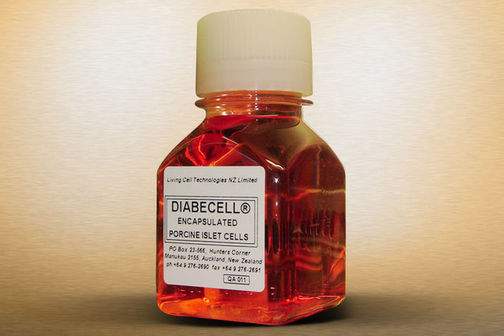Clinical trials of Living Cell Technologies (LCT) pig cell transplants began in 2009. The trials show that encapsulated pig cells are safe and improve blood sugar control in type 1 diabetics. Research published in 2016 continues to support these findings.
Problems with treatment of type 1 diabetes
People with type 1 diabetes have to inject insulin at least 3–4 times a day. This impacts on every aspect of their life and has serious short-term and long-term health implications. The best currently available diabetes treatment combines an implanted blood sugar monitoring device and automated insulin pump. However, these are uncomfortable to wear so most patients prefer not to use them. Find out more about Diabetes and pig cell transplants in this article.
Developing a new medical treatment
LCT is developing pig cell transplants to provide a better treatment for type 1 diabetes, which improves patients’ quality of life. All new medical treatments must undergo rigorous testing before they are available for general use. Testing ensures new treatments are safe and effective and also helps determine the best doses and treatment schedules.
Pig cell transplants
LCT’s treatment is called DIABECELL. It consists of encapsulated live pig cells, called islets of Langerhans (or islets), which produce insulin in response to blood sugar levels. They are encapsulated to protect them from rejection by the patient’s immune system. DIABECELL is designed to give type 1 diabetics better control of their blood sugar levels.
Trialling transplants in animals
Preliminary tests for safety and effectiveness are usually done in animals. LCT has trialled its pig cell transplants in animal models of diabetes. They found that the transplants were safe and effective, and since 2009, have been testing the transplants in people with diabetes.
Trialling transplants in type 1 diabetics
Clinical trials of DIABECELL are now being done in several countries. The first trial was in Russia, and trials are under way in New Zealand and Argentina. The encapsulated pig cells are transplanted into patients with type 1 diabetes that have ‘unaware hypoglycaemia’. This is a life-threatening condition where patients can’t tell when their blood glucose is too low and may become unconscious with very little warning. Unaware hypoglycaemia causes 8% of deaths in type 1 diabetes.
Using the right amount of cells
The clinical trials also aim to determine the most effective dose of encapsulated pig cells to use. A dose is the number of encapsulated islets of Langerhans per kilogram of body weight and is normally about 5,000–10,000. LCT’s trials have shown that there is an optimum dose of cells, and adding more cells doesn’t make the treatment better. This could be because, when too many cells are transplanted, they don’t all get a good enough blood supply and some die.
The life span of a transplanted pig cell
The first person to receive one of LCT’s pig cell transplants was Michael Helyer in 1996. He had type 1 diabetes with unaware hypoglycaemia. He received an early prototype of encapsulated pig cells, which enabled him to reduce his insulin injections and gave him better control of his blood sugar. The effects appeared to wear off, but Michael felt the cells were still working. He was right! 10 years later, LCT took a sample of the cells in Michael’s abdomen and found some of them were still alive and producing pig insulin.
Results and future of DIABECELL
The clinical trial results so far have been very positive. Overall, trial patients have much better control of their blood sugar levels and fewer episodes of low blood sugar. In some cases, the patients significantly reduced the amount of insulin they needed to inject.
LCT’s goal is to find a better treatment for type 1 diabetes, and they are well on their way to achieving this.
Useful links
Keep up to date with the latest developments with Algorae Pharmaceuticals Ltd (previously LCT) and Diabecell (now owned by Diatranz Otsuka Limited).

